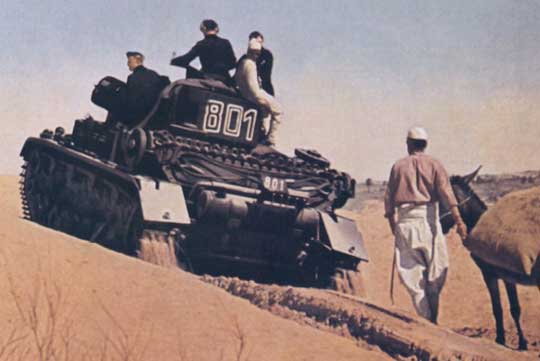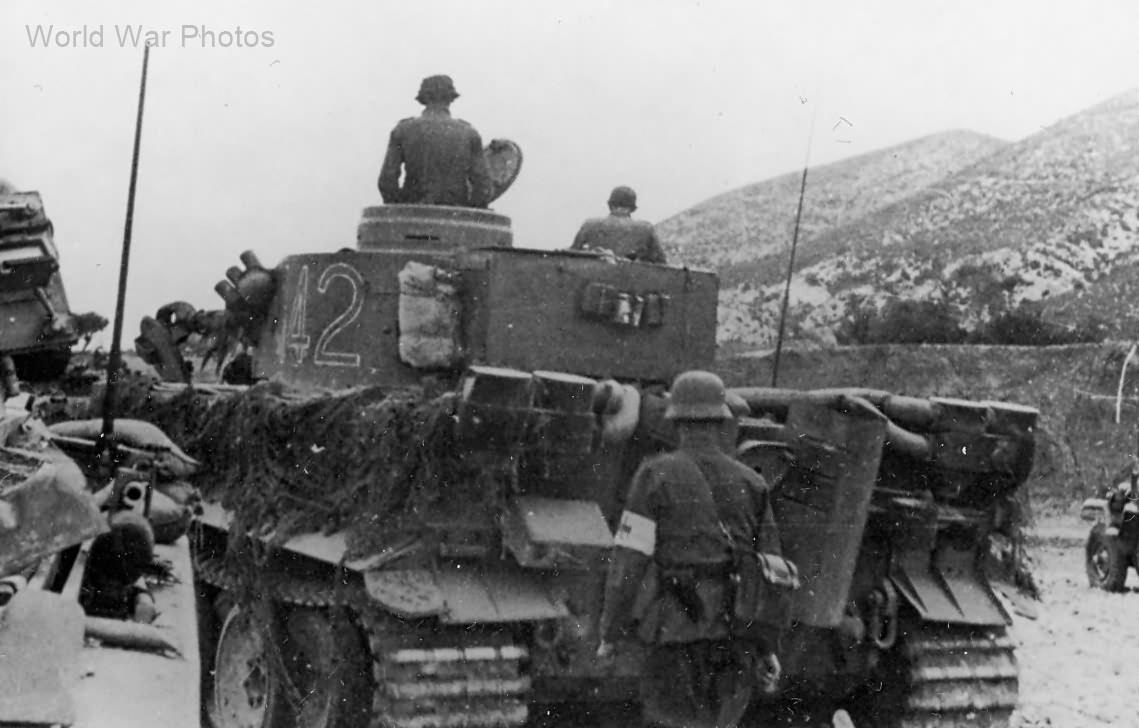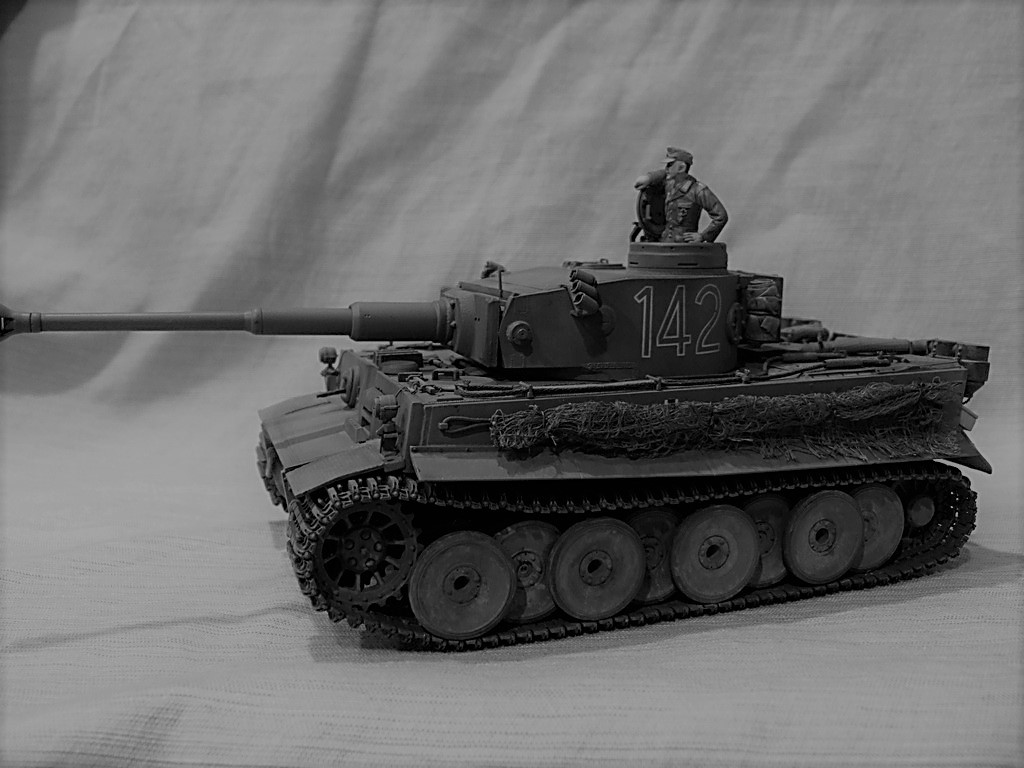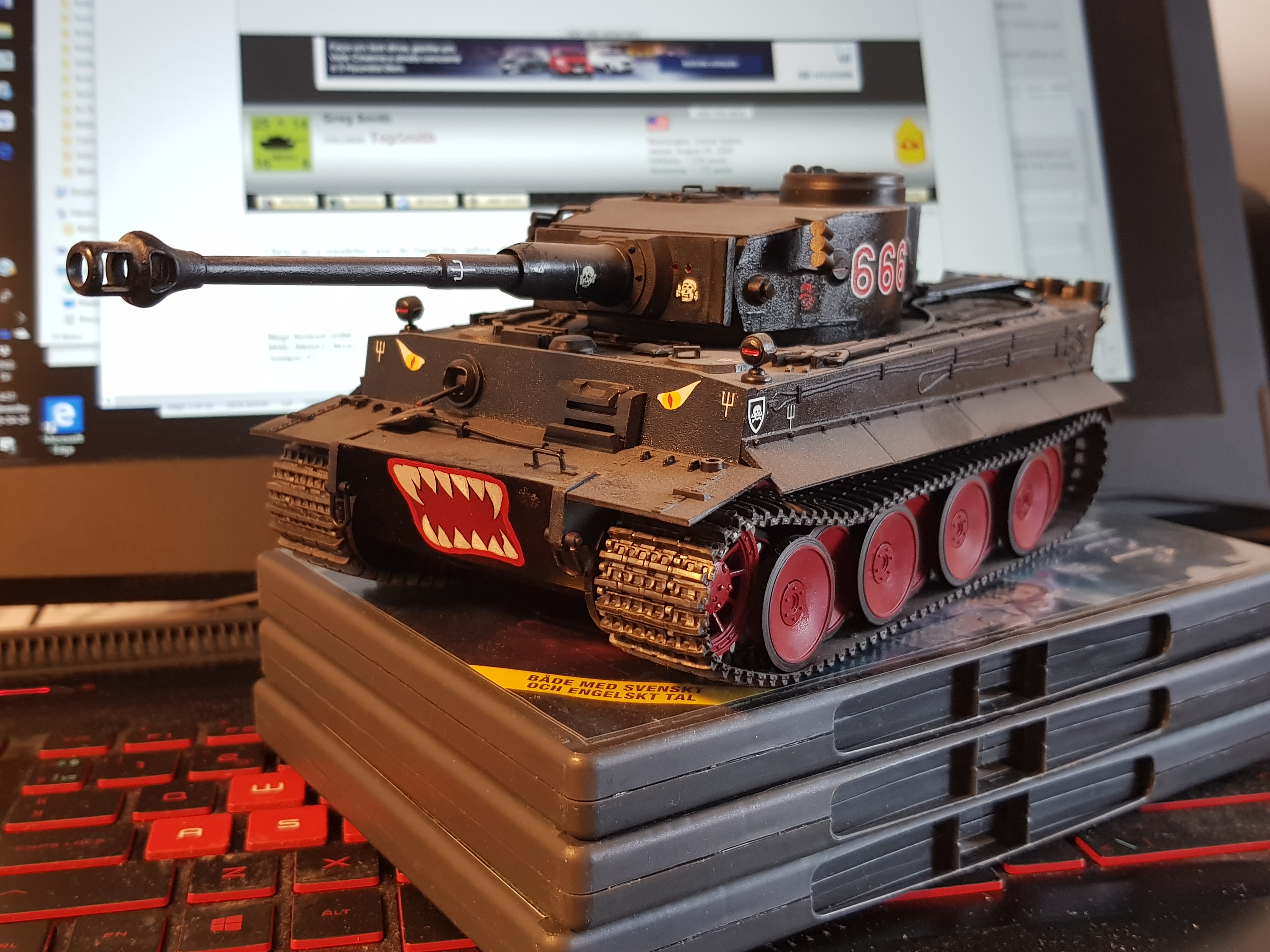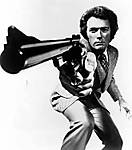Hey David
here we go ...
1. They are more reliable researchers, in just about everybody's opinion. They use original sources only.
... is that so ? .... so all other research is there for less reliable ? In just about everybody's option. .... Since the others also use non-original sources (what ever that might be ?)
2. You a right I should have mentioned I was referring to "Tigers in combat III" to be more precise.
3. HM 181 / 18.02.1943 is the order to change from "Dunkelgrau" to "Dunkelgelb" as base color, camo (Green + Brown) to be applied by the troops:
H. M. 1943, Nr. 181
181. Anstrich des Heeresgeräts.
1. Gerätanstrich.
An Stelle des bisherigen Gerätanstrichs, dunkelgrau- dunkelbraun, der für Kriegsdauer in einfarbig dunkelgrau abgeändert worden ist, sowie an Stelle des Gerätanstrichs braun-grau für die Truppen in Afrika und auf Kreta, tritt für Großgerät mit sofortiger Wirkung der Anstrich
dunkelgelb nach Muster.
Nummer der RAL-Farbtonkarte für dieses dunkelgelb wird später festgesetzt. Muster sind beim Heereswaffenamt Wa J Rü (W u G 1/V), Berlin W 15, Sächsischestr. 8, aufzufordern.
Für Kleingerät, das in Fahrzeugen mitgeführt wird (z. B. Nachrichtengerät, Vorratkasten, Werkzeugkasten, Kasten und Koffer des Veterinärgeräts, Aktenkasten) ist der bisherige Anstrich bis auf weiteres beizubehalten.
Für den Anstrich ist zu verwenden:
P-Farbe nach TL 6321 für Panzerkampfwagen,
W-Farbe nach TL 6320 für Funk- und Nachrichtengerät,
Deckfarbe nach TL 6337 für Gerät aus Magnesiumlegierungen (z. B. Elektronräder an Geschützen),
im Übrigen Kunstharzfarbe nach TL 6317 B. Entgegenstehende Bestimmungen treten außer Kraft.
2. Tarnanstrich. Die Tarnung des Geräts durch Auftragen entsprechender Farben nach den jeweiligen Feldverhältnissen ist Sache der Truppen. Hierzu sind von den Truppen Tarnpasten (3) mitzuführen in folgenden Farben:
olivgrün nach Farbtonkarte des R. L. M. für Tarnfarben (Gebäude- und Bodentarnung),
rotbraun, RAL 8017,
dunkelgelb nach Muster wie in Ziffer 1.
3. Die Tarnpasten nach Ziffer 2 werden an die Truppen im Nachschubwege abgegeben. Zur Berechnung der Gesamtmenge für jede Einheit gelten folgende Pauschalsätze: ...
Abgabe der Tarnpasten erfolgt in Packgefäßen von 2 und 20 kg. Die Gesamtmenge je Einheit ist auf eine durch 2 teilbare Zahl abzurunden, bei Mengen über 20 kg sind zunächst Packgefäße von 20 kg, für den Rest solche von 2 kg anzusetzen.
Es muss im Hinblick auf die bestehende Rohstoff, Fertigungs- und Transportlage den Truppen zur Pflicht gemacht werden, mit Farbe und Tarnpasten sorgsam umzugehen und den Verbrauch auf das dringend Notwendige zu beschränken.
4. In welchen Formen die Tarnpasten aufzutragen sind, wird dem Ermessen der Truppen überlassen. Es wird meistens darauf ankommen, die Fläche eines Geräts (Fahrzeugs) durch verschiedene Farben für die Sicht zu zerteilen.
Im allgemeinen hat sich das Auftragen in größeren Farbflecken unter Vermeidung jeder Regelmäßigkeit (»wolkenartig«) bewährt.
Die Tarnpasten sind im Anlieferungszustand oder nach Zugabe von Wasser oder Treibstoff zu verwenden. Sie können außer mit Pinsel auch mit Behelfsmitteln (Bürsten, Lappen) aufgetragen werden und sind nach kurzer Zeit trocken. Sie eignen sich auch zum Tarnen von Wagenplanen.
Soweit eine Beseitigung aufgetragener Tarnpasten notwendig ist, kann sie mit Treibstoff vorgenommen werden.
5. Die Wintertarnung (in schneebedecktem Gelände) besteht bis auf weiteres in weißem Anstrich mit Emulsionsfarbe nach TL 6345. Alles Gerät, das bis Ende Februar 1943 an die Feldtruppen abgegeben wird, ist vor Absendung mit diesem Anstrich zu versehen.
Einführung weisser Tarnpaste zur Wintertarnung wird später angeordnet.
6. Übergangsbestimmungen.
a) Gerät in Neufertigung, das etwa schon den bisherigen Anstrich erhalten hat, ist vor Ablieferung nach Ziffer 1 umzustreichen oder - Gerat aus Webstoff - umzufärben.
b) Gerät in den Beständen ist nur noch mit Anstrich oder Färbung nach Ziffer 1 abzugeben. Dieses Gerät ist außerdem mit weißer Emulsionsfarbe zu überstreichen, soweit es bis Ende Februar 1943 abgesendet wird (5).
c) Bei den Feldtruppen wird der Anstrich des dort bereits vorhandenen Geräts (dunkelgrau oder - bei Truppen in Afrika und auf Kreta – braun-grau) nicht geändert. Notwendige Tarnung ist mit Tarnpaste (2 bis 4) durchzuführen.
d) Bei den Ersatz- und Besatzungstruppen ist das Gerät mit neuem Anstrich nach 1 zu versehen. Die hierzu erforderliche Farbe (1 Abs. 4) sowie die zustehende Tarnpaste (2, 3) ist von den Truppenteilen im Nachschubwege anzufordern. Umfärben von Wagenplanen muss jedoch mit Tarnpaste erfolgen.
O. K. H. (Ch H Rüst u. BdE), 18.2.43 - 72/88/16 - In. 2 (V)
OKW WA J Rü 6/VIII / 19.08.1944 is the only order I'm aware of which orders camo to be applied in factory by the producer:
H. V. 1945, Nr. 52
52. Anstrich des Heeresgeräts. Neufertigung
1. Das Heeresgerät der Neufertigung wird, soweit ein Anstrich noch zugelassen ist, an Stelle des Gelbanstriches (RAL 7028) mit einem Grünanstrich versehen.
Für den Farbton ist maßgebend die RAL-Farbtonkarte 6003, Anstrichstoffe wie bisher.
2. Welche Geräte, abweichend von den Angaben in den Zeichnungen und Gerat- Lieferbedingungen, noch einen Anstrich erhakten, ist aus den neuen Anstrichvorschriften ersichtlich, die allen H Abn-Dienststellen Okt. 44 zugegangen sind.
3. Geräte, für die entsprechend dieser Anstrichvorschrift in der Neufertigung ein Buntfarben-Tarnanstrich vorgesehen ist, sind solange grün zu streichen, bis das entsprechende „Tarnbild“ als Vorlage zur Verfügung steht. Die Tarnbilder werden den Firmen nach Fertigstellung durch die Beschaffungsabteilungen des Heereswaffenamtes zugeleitet.
4. Die Farbtone für den Buntfarben-Tarnanstrich sind: Grün RAL 6003
Braun RAL 8017 } RAL-Farbtonregister 840 R
Gelb RAL 7028 Ausgabe 1944
Für den Buntanstrich werden sie flächenmässig in ungefähr gleichen Mengen benötigt.
5. Vorhandene Bestände an gelber Farbe (Farbton RAL 7028) sind für folgende Zwecke aufzubrauchen:
a) für Kleingerät, soweit es sich nicht um Gerät handelt, das der Mann ständig bei sich trägt,
b) für Geräte, die nur im Heimatkriegsgebiet eingesetzt werden, c) für den gelben Anteil des Buntfarben-Tarnanstrichs.
In Zweifelsfällen zu a) und b) ist über die Heeres-Abnahme-Dienststellen Entscheidung einzuholen.
Die Heeres-Abn-Dienststellen haben bis zur Herbeiführung der Entscheidung die Weiterverwendung der gelben Farbe zu tolerieren, auch für Großgeräte
.... is there an HM or OKW WA (or similar) previous to HM 181 instructing Henschel to apply the "Tropen" camo already at the factory ?
3. If you're saying that the Bovington Tiger was grey when it rolled out of the factory
.... You mentioned that yourself in an article that grey color was found after the gun mantlet was removed and it had to be applied prior to the installation of the gun mantlet. Wegmann delivered their turrets already painted in the ordered base coat ... any other camo came on top ... so if HM 181 was obeyed then all camo was to be applied by the troops.
So why would Henschel act otherwise ? They would deliver in one uniform color ... Dunkelgrau and later Dunkelgelb.
I don't believe a manufacturer would divert from this order, trouble with the WA and no reimbursement. There would have to be a change order to their existing contract ... issued by whom ?
Do you know of any such document by chance ? Because this is an "original" source which clearly only mentions the use of .... " Dunkelgrau for the duration of the war and Braun-Grau for Africa and Crete both to be replaced by Dunkelgelb ... specific RAL# (Dunkelgelb) to be specified at a later date".
... no other RAL # / is mentioned here.
My conclusion is that only orders for Dunkelgrau, camo for Africa and for the island of Crete were in existence/use and were all replaced by Dunkelgelb.
5. This is not one of the February Tigers. Given the supply dates of Tigers to 502, this one was finished after the introduction of Dunkelgelb.
..... do you know on which day/date Henschel started apply Dunkelgelb as to HM 181 ? I don't.
Reminder:
In November, 2011, after reviewing the draft copy of my paper on the effects of the Royal Air Force’s October 22/23, 1943 fire bombing of the City of Kassel on Tiger 1 tank production, the late Mr.Tom Jentz, despite his illness, forwarded his comments and suggestions. The following are some
of his comments :
“It was war time. The idea was to get tanks out the factory door as quick as possible”
“Henschel didn’t care what a Tiger tank looked like. They didn’t care what mods they had. All they cared about was getting an assembled tank passed by the inspectors and getting paid for it”.
“The assembly workers would assemble a vehicle with whatever was on hand and whatever was most easily accessible. The workers didn’t care if they put on regular wheels or steel wheels. It was all the same to them and no one was checking off what mods were going on”.
Cheers
Christopher









